Bus tickets, mid-20th century UK
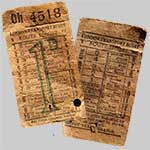
Bus tickets are proof that passengers have paid their fares for their bus journeys, but the tickets themselves and how they were bought and sold was different in the past compared with today. Although this page focuses on the mid-20th Century passenger experience of the London Transport bus ticket system, internet images show that identical systems were in place elsewhere in the country and even overseas.
____
By the webmaster, based childhood observations with discussions and contributions from people who used buses with these bus tickets
I well remember the bus tickets when I was young in the 1940s and 50s. They were made of rough coloured paper, and the size, according to The London Transport website, was 64mm by 32mm. Not of course that we ever thought of measuring them.
Bus ticket racks
These early tickets were held on a rack which the bus conductor carried, and they were kept in place with springs as shown in the following photographs.
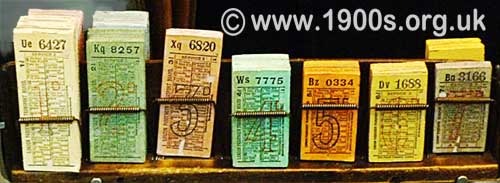
Bus conductor's rack of London Transport bus tickets. Note the spring fasteners that kept the tickets in place while enabling the conductor to pull out a single ticket easily for each passenger. Photographed in the London Transport Museum.
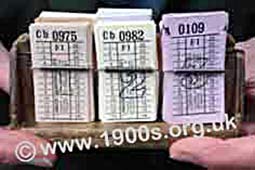
Smaller ticket rack for use on short journeys, photographed in London Bus Museum at Brooklands
Each denomination of bus ticket was of a different colour and had various destinations and fare stages printed on it. The large overprinted numbers show the fares in old money and range here from 1 old penny to 7 old pennies. Fancy going on a bus journey for that price today with one old penny equivalent to one 240th of a pound! An excellent example of inflation.
Tram and trolleybus tickets
contributed by Mike Wheale
The ticket system for trams and trolleybuses was identical to that on buses.
Validated bus tickets, ticket inspectors and bus breakdowns
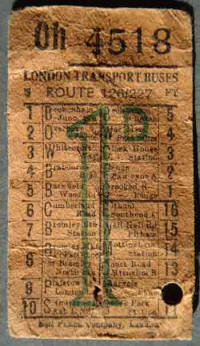
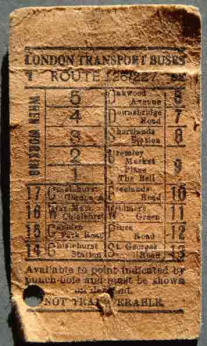
Front and back of a used 1940s London bus ticket showing its price and a punch hole indicating the bus stop where the passenger must get off. Courtesy of Francis Duck.
Tickets were sold by the bus conductor on the bus. They couldn't be bought in advance. They had to be kept carefully until the end of the journey. One reason was that every so often a ticket inspector would board the bus at a bus stop along the route and check everyone's ticket. Another reason was that buses frequently broke down, which I suppose was due to the lack of availability of parts during the shortages of the war and the years of austerity afterwards. When this happened, all the passengers had to crowd out to wait for the next bus to come along. Then they had to show their tickets to the new conductor in order to avoid double payment.
A childhood use for used tickets
contributed by Barry Davis
As lads at that time, we used to raid the used ticket box on the rear platform of buses to obtain more tickets for our used ticket collections.
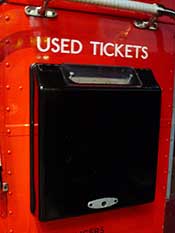
Wall container on buses for used bus tickets
Bus journey fares and bus tickets
Passengers had some check on the fare they should be paying because a grid showing 'fare stages' between bus stops was displayed in the bus, usually above the luggage hold. Fare stages were usually between fairly well-used bus stops.
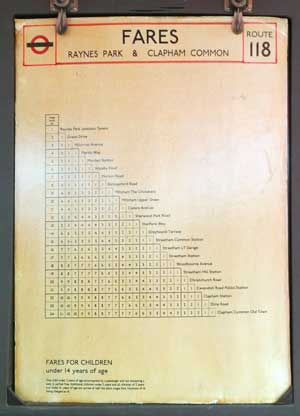
Grid showing the price of journeys between 'fare stage' bus stops
Changes to bus tickets, late 1950s-60s
Some years after the war, a new type of bus ticket was introduced. The paper was on a roll and tickets were printed specially for each customer's journey. The bus conductor had the machine round his neck and shoulders and operated it with a handle. Then out popped the ticket which he tore off and gave to the passenger. These tickets had to be kept during journeys, just as the earlier style tickets had been.
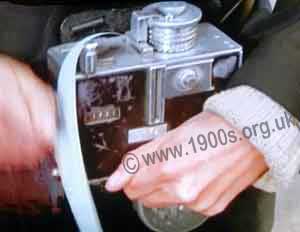
One of several types of machine for printing bus tickets, carried by bus conductors over the shoulder on a belt, c1960s.
Types of machine for printing bus tickets
contributed by Paul Rippingham
The style of machine in the picture looks typical of those used on the former Southdown buses here in Sussex. The more typical London Transport bus conductor's ticket machine of the period was the Gibson, a distinctive chunky bull-nosed one with a ticket winder handle on one side and a fare selector wheel on the other. In Horsham (the outermost southern limit of what was then the large London Transport Country Buses green bus network), it was used extensively in the 1960s and early 1970s including the 'alien' red ones that were drafted in because of the-then bus shortage.
I well remember one day the bus turning round fast when the unfortunate conductor's neck strap broke and the machine rolled off the open rear platform and onto the road.
Date of the changeover from rack to machine bus tickets
contributed by Susan Brind
In Morden in Surrey, the changeover from rack tickets to machine must have taken place sometime before July 1958. I remember because I left my primary school then and my class always used to go by bus to the swimming baths weekly. It was fun to compete to get hold of the bus tickets – all 23 of them, which spewed out in a long strip as shown in the above photo.
Bus tickets for pay-as-you-enter buses
Drivers selling bus tickets from their driving seats as passengers got onto a bus was years away. When it came, it must have saved money for the bus companies because one person rather than two were required to staff each bus.
Drivers' ticket printing machines in pay-as-you-enter buses
contributed by Paul Rippingham, comment
The machine for printing bus tickets was mounted in a cradle on the internal driver's half-door of the later pay-as-you-enter buses.
| sources | webmaster | contact |
Text and images are copyright
If you can add anything to this page or provide a photo, please contact me.



